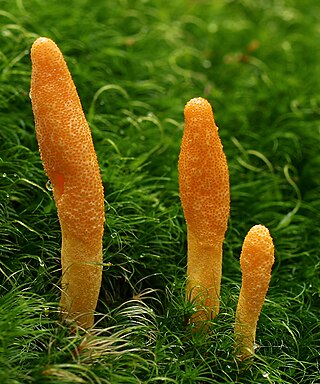Related Research Articles

Cordyceps is a genus of ascomycete fungi that includes about 600 worldwide species. Diverse variants of cordyceps have had more than 1,500 years of use in Chinese medicine. Most Cordyceps species are endoparasitoids, parasitic mainly on insects and other arthropods ; a few are parasitic on other fungi.

Beauveria bassiana is a fungus that grows naturally in soils throughout the world and acts as a parasite on various arthropod species, causing white muscardine disease; it thus belongs to the group of entomopathogenic fungi. It is used as a biological insecticide to control a number of pests, including termites, thrips, whiteflies, aphids and various beetles. Its use in the control of bedbugs and malaria-transmitting mosquitos is under investigation.

An entomopathogenic fungus is a fungus that can kill or seriously disable insects.

Metarhizium robertsii – formerly known as M. anisopliae, and even earlier as Entomophthora anisopliae (basionym) – is a fungus that grows naturally in soils throughout the world and causes disease in various insects by acting as a parasitoid. Ilya I. Mechnikov named it after the insect species from which it was originally isolated – the beetle Anisoplia austriaca. It is a mitosporic fungus with asexual reproduction, which was formerly classified in the form class Hyphomycetes of the phylum Deuteromycota.

Tarsonemidae is a family of mites, also called thread-footed mites or white mites.

Beauvericin is a depsipeptide with antibiotic and insecticidal effects belonging to the enniatin family. It was isolated from the fungus Beauveria bassiana, but is also produced by several other fungi, including several Fusarium species; it may therefore occur in grain contaminated with these fungi. Beauvericin is active against Gram-positive bacteria and mycobacteria, and is also capable of inducing programmed cell death in mammals.

Mycoviruses, also known as mycophages, are viruses that infect fungi. The majority of mycoviruses have double-stranded RNA (dsRNA) genomes and isometric particles, but approximately 30% have positive-sense, single-stranded RNA (+ssRNA) genomes.

Giuseppe Gabriel Balsamo-Crivelli was an Italian naturalist.

Beauveria is a genus of asexually-reproducing fungi allied with the ascomycete family Cordycipitaceae. Its several species are typically insect pathogens. The sexual states (teleomorphs) of Beauveria species, where known, are species of Cordyceps.
Phoma exigua var. foveata is a fungal plant pathogen infecting potatoes.

A fungus is any member of the group of eukaryotic organisms that includes microorganisms such as yeasts and molds, as well as the more familiar mushrooms. These organisms are classified as one of the traditional eukaryotic kingdoms, along with Animalia, Plantae and either Protista or Protozoa and Chromista.

Jean Paul Vuillemin was a French mycologist born in Docelles.

Muscardine is a disease of insects. It is caused by many species of entomopathogenic fungus. Many muscardines are known for affecting silkworms. Muscardine may also be called calcino.

Jean Beauverie was a French botanist and mycologist.

Curculio elephas is a species of beetle in the family Curculionidae, the true weevils. It is known commonly as the chestnut weevil. It is a serious pest of chestnut in Europe.

Bertia is a genus of fungi within the Bertiaceae family, and Hypocreomycetidae subclass.

Platypus apicalis, known by its common name the New Zealand pinhole boring beetle, is a wood-boring beetle endemic to New Zealand and found throughout the North and South Island in a range of environments.

Odoiporus longicollis, commonly known as banana stem weevil or banana pseudostem borer, is a species of weevil found in South Asia and South East Asia.
Donald W. Roberts was an American insect pathologist and one of the originators of that field. He was especially known for research into biological pest control of Lepidoptera by Metarhizium but also Beauveria bassiana. He was a Research Professor Emeritus in the Biology Department of Utah State University.
Batkoa major is a naturally occurring fungus.
References
- Markova, G. (1991). "Melanospora parasitica attacking Beauveria bassiana on ash weevil Stereonychus fraxini in Bulgaria". Journal of Invertebrate Pathology. 58 (3): 450–452. doi:10.1016/0022-2011(91)90193-T.
- Müller-Kögler, E. (1961). "Melanospora parasitica Tul. als Parasit der insektenpathogenen Beauveria tenella (Delacr.) Siem". Zeitschrift für Pflanzenkrankheiten und Pflanzenschutz. 68: 600–605. JSTOR 43232268.
- Petch, T. (1931). "Notes on entomogenous fungi". Transactions of the British Mycological Society. 16 (1): 55–75. doi:10.1016/S0007-1536(31)80006-3.
- Posada, F.; F. E. Vega; S. A. Rehner; M. Blackwell; D. Weber; S.-O. Suh & R. A. Humber (2004). "Syspastospora parasitica, a mycoparasite of the fungus Beauveria bassiana attacking the Colorado potato beetle Leptinotarsa decemlineata: A tritrophic association". Journal of Insect Science. 4: 24. doi:10.1673/031.004.2401. PMC 528884 . PMID 15861239.